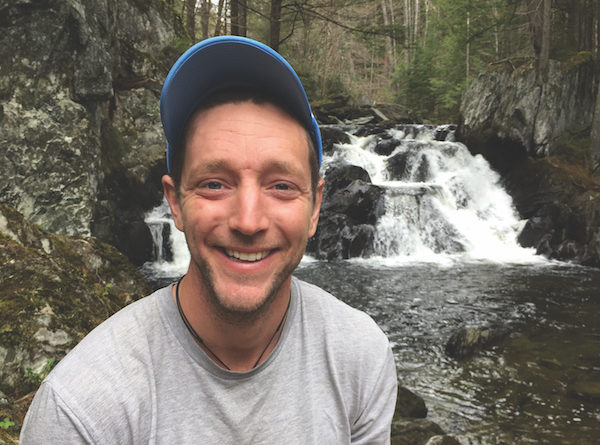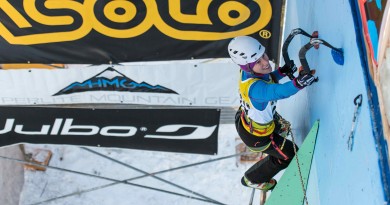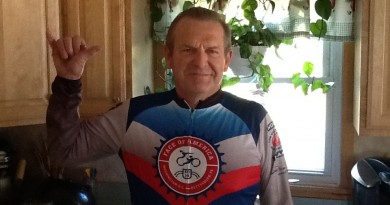Meet the Trail Builder
The Trail Builder
Name: Sam Brakely Age: 31
Lives in: Sharon
Family: Five siblings
Primary Sports: Skiing, canoeing, backpacking, and rugby
Sam Brakely likes covering distance trails—over dirt, over snow and through water. He has completed the Long Trail, the Appalachian Trail, the Catamount Trail and the Northern Forest Canoe Trail. A professional trail builder, Brakely may also be the only winner of the North American Wife-Carrying Championships to be featured in Vermont Sports.
How on earth did you end up at the North American Wife Carrying Championship?
I have a cousin who is an avid wife-carrier and he competed for a number of years and won the fifth time he entered. He was going to defend his title at Sunday River, Maine, in 2015 but he broke his foot. He and his wife came over for dinner one night and I pitched the idea of taking his place. I picked her up and ran around the house and jumped over some couches. That was the extent of our training, but we were fortunate enough to win. The winner gets five times the woman’s weight in cash, as well as in beer so they put her on one end of a seesaw and keep piling cases of beer on the other end until it evened out. Unfortunately, it was Bud Lite. This winter they tried to hold the event as a snowshoe race, but it was cancelled because of rain. If they do it again, I might compete in that.
How did you carry your cousin’s wife?
I used what they call the Estonian Carry which is what 99 percent of people participating used. The woman is upside down which puts most of her weight on your shoulders instead of down around your waist and allows her to most effectively use her own strength to really latch onto you. That means you can focus the entirety of your own efforts on racing which is more or less moving at a quick trot given the weight on your shoulders and the awkward phenomenon of it being a person. It’s super important for her to squeeze as tight as she can and hold herself as still and as close to you as possible. It might look like she’s not doing much but she’s actually working nearly as hard as you are—and doing it while she is upside down!
You seem to have a knack for long-distance trails. Of all the ones you’ve completed, which was the most satisfying?
They are all satisfying in different ways. Some I’ve done with partners and some solo. Some are along popular routes, but others are historical. They have all come at times of my life when I felt like I needed to get away from things and tackle life with a new outlook. It’s a bit of an escape from the daily routine and it allows me to reset and find my even keel and move forward from there.
Was the Long Trail the first?
I did the Long Trail in May and June of 2007 when I was 19 and had a wonderful time. I wasn’t entirely sure what I was doing but I figured it out along the way and was really helped by an experienced hiker I met on the trail.
What was next?
I decided to do the Appalachian Trail in 2008. The Long Trail was through my backyard, so I wanted something bigger and more challenging. The L.T. was such a positive experience that I headed out on the A.T. in early March and finished in mid-July.
And next up was the Northern Forest Canoe Trail?
By that point I was starting to think about the history of some of these trails. I had a background in canoeing from my teenage years at a traditional canoe camp called Keewaydin in Salisbury. When I went on the trail with my friend Andy Rougeot, we used a traditional canoe which weighed 50 pounds, wannigans (wooden boxes) and cooked over a fire. That’s what I knew. It was only later that I learned most people use lightweight boats and stoves. The heavier canoe wasn’t really a problem for the portages because many of them were along roads and the footing was better than what I was used to, although a six-mile portage is nobody’s idea of a walk in the park.
And then you moved from water to snow.
I did the Catamount Trail in January/February of 2015. The first day I had snow sticking to my skis but then it got pretty frigid for the rest of the trip. During the second half, the temperatures were in the negative teens and it bottomed out one night at 22 below. It also snowed most days, so I got fresh tracks and was often breaking trail. The snow and cold made it challenging but I didn’t have to deal with crust or sticky snow except for the first day so gliding was no problem. I had new boots and skis for the trip and I had warm gloves and a coat but otherwise I used a lot of old gear and a summer-weight tent. I used a backpack instead of toting a sled.
Clearly you must have enjoyed it because you wrote a book about it.
Skiing with Henry Knox: A Personal Journey along Vermont’s Catamount Trail is the third book I’ve written. I wrote one about the Northern Forest Canoe Trail and one about a solo canoe trip through Maine and Quebec. Those are self-published but for this book I’m working with Islandport Press out of Maine. The book is due out in October. It’s three stories intertwined. One is about Henry Knox, a Revolutionary War general who made a 300-mile winter journey from Fort Ticonderoga to Cambridge, Massachusetts carrying cannons on oxen-drawn sleighs. He kept a journal and I drew my information from that. The second story was about my own 300-plus mile ski on the trail and the third was a bit about my life story. My partner was moving to Utah to continue her medical career and I was struggling with whether to follow her or not. All my roots and family and business were here, and I was debating whether to chase her across the country. The three tales are intertwined.
Tell us about your trail-building business.
Hermit Woods Trail Building does dry stone masonry and trail work. We’re probably divided 50/50 between things like patios, walls, and stairs, and trail projects throughout Vermont and New Hampshire. Our trail building is usually related to stone, as well. Some of the trails we’ve done include an ADA-accessible trail at VINS in Quechee and hundreds of steps up Gile Mountain in Norwich in partnership with the Upper Valley Trails Alliance. We’ve also worked with The Nature Conservancy in North Hero to improve their Butternut Hill Natural Area trails, and the Vermont River Conservancy to build a number of river access projects including ones to the White and Winooski Rivers and a project to improve access to the Bolton Potholes with a series of stone staircases. The company is me, two full-time employees and one part-time worker. I’m a certified instructor and a Level 2 Certified Dry Stone Waller through the Dry Stone Walling Association. I teach the occasional class and I’ve guest lectured at Vermont Technical College.
What trail will you tackle next?
I just did a two-month trip to New Zealand. There is a trail called Te Araroa which means long pathway in Maori. It’s a 3,000-mile trail which runs the length of both islands and I did 1,400 miles on the South Island from end to end. I’d never been to that part of the world before. It had stunning vistas, mountains and scenery and wonderful people; both those who traveled from across the world to hike there and natives. That was my first long distance international trail unless you count Canada. It was interesting to combine a slightly different culture and lifestyle. I think my next trip will also be abroad. I’d like to continue having a new culture as a component so I’m looking at a couple of options but I’m hoping to go someplace where English isn’t the native language.
Why do you enjoy your long-distance treks so much?
I love the lifestyle, specifically how simplified it becomes. Each day there is a single goal of getting from point A to point B and that gives structure to the day. Besides eating and sleeping, the rest of the day is moving across the landscape, traveling at a human powered speed and taking it all in and interacting with folks you meet along the way. Breaking it down to the basics is simple and powerful and helps me take a deep breath and put both feet on the ground for when I return to the “other” world of day to day life. It helps me reset my mind and body.
–Phyl Newbeck



